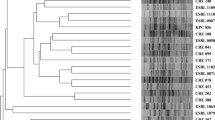Abstract
The efficacy of the clinically available β-lactam/β-lactamase inhibitor combinations (amoxicillin/clavulanic acid (CA), ticarcillin/CA, amoxicillin/sulbactam, and piperacillin/ tazobactam) was evaluated on 300 amoxicillin-resistantEscherichia coli isolates having the main patterns of β-lactam resistance. The patterns, which reflect the production of various β-lactamase enzymes, were analyzed by a principal component analysis of susceptibility to 11 β-lactam antibiotics or β-lactam/β-lactamase inhibitor combinations. Sixty-two percent of strains were not very susceptible to penicillins, cephalothin, or any β-lactam/β-lactamase inhibitor combinations except for piperacillin/tazobactam; these strains may represent high-level broad-spectrum β-lactamase (so-called penicillinase) production phenotype or inhibitor-resistant TEM-like enzyme production phenotype. Of the strains, 14.7 % were resistant to amoxicillin and ticarcillin compatible with low-level broad-spectrum β-lactamase production phenotype; 5.7 % were cefoxitin resistant and were postulated to present a high-level cephalosporinase production phenotype; and 2.6 % were resistant to cephalothin only, attributable to a low-level cephalosporinase production phenotype. Three percent of strains were intermediate or resistant to cefotaxime and may produce an extended-spectrum β-lactamase, and the remaining strains (12 %), resistant to all tested antibiotics except for cefotaxime and piperacillin/tazobactam, were hypothesized to produce both broad-spectrum β-lactamase plus cephalosporinase. The minimal inhibitory concentration (MIC) for these phenotype patterns indicated that combinations of CA plus amoxicillin or ticarcillin, or sulbactam plus amoxicillin, restored the activity of penicillins against phenotype 1 strains, whereas these combinations remained inactive against the other phenotype strains. Piperacillin plus tazobactam showed the best in vitro effect against the strains of all resistance phenotypes.
Similar content being viewed by others
References
Medeiros AA: Beta-lactamases. British Medical Bulletin 1984, 40: 18–27.
Jacobs MR, Aronoff SC, Johenning S, Shlaes DM, Yamabe S: Comparative activities of the β-lactamase inhibitors YTR 830, clavulanate, and sulbactam combined with ampicillin and broad-spectrum penicillins against defined β-lactamase producing aerobic gramnegative bacilli. Antimicrobial Agents and Chemotherapy 1986, 29: 980–985.
Kuck NV, Jacobus PJ, Petersen PJ, Weiss WJ, Testa RT: Comparative in vitro and in vivo activities of piperacillin combined with the β-lactamase inhibitors tazobactam, clavulanic acid and sulbactam. Antimicrobial Agents and Chemotherapy 1989, 33: 1964–1969.
Hamilton-Miller JMT: Beta-lactamases and their clinical significance. Journal of Antimicrobial Chemotherapy 1982, 9, Supplement B: 11–19.
Acar J, Bergogne-Berezin E, Brognard JM, Chabbert Y, Cluzel R, Courvalin P, Dabernat H, Drugeon H, Dubreuil L, Duval J, Flandrois JP, Goldstein F, Meyran M, Morel CI, Philippon A, Sirot J, Thabaut A: Communiqué 1993 du Comité de l'Antibiogramme de la Société Française de Microbiologie. Pathologie Biologie 1993, 41: 741–748.
Mathew M, Harris AM, Marshall MJ, Ross GW: Use of analytical isoelectric focusing for detection and identification of β-lactamases. Journal of General Microbiology 1975, 88: 1969–1978.
Labia R, Barthelemy M: L'enzymogramme des β-lactamases: adaptation en gel de la méthode iodométrique. Annales de Microbiologie 1979, 130B: 295–304.
Dixon W: BMDP. Statistical Software, University of California Press, Berkeley, 1981.
Thomson CJ, Amyes SJB: TRC-1. Emergence of clavulanic acid-resistant TEM-β-lactamase in a clinical strain. FEMS Microbiology Letters 1992, 91: 113–118.
Vedel G, Belaaouaj A, Gilly L, Labia R, Philippon A, Nevot P, Paul G: Clinical isolates ofEscherichia coli producing TRI β-lactamases, novel TEM-enzymes conferring resistance to β-lactamase inhibitors. Journal of Antimicrobial Chemotherapy 1992, 30: 449–462.
Bauernfeind A, Hörl G: Novel R-factor borne β-lactamase ofEscherichia coli conferring resistance to cephalosporins. Infection 1987, 15: 257–259.
Martinez JL, Cercenado E, Rodriguez-Creixems M, Vicente-Perez MF, Delgado-Iribarren A, Baquero F: Resistance to β-lactam/clavulanate. Lancet 1987, ii: 1473.
Blazquez J, Baquero MR, Canton R, Alos I, Baquero F: Characterization of a new TEM-type β-lactamase resistant to clavulanate, sulbactam and tazobactam in a clinical isolate ofEscherichia coli. Antimicrobial Agents and Chemotherapy 1993, 37: 2059–2063.
Zhou XY, Bordon F, Sirot D, Kitzis MD, Gutmann L: Emergence of clinical isolates ofEscherichia coli producing TEM-1 derivatives or an OXA-1 β-lactamases conferring resistance to β-lactamase inhibitors. Antimicrobial Agents and Chemotherapy 1994, 38: 1085–1089.
Papanicolaou GA, Medeiros AA, Jacoby GA: Novel plasmid-mediated β-lactamase (MIR-1) conferring resistance to oxyimino and α-methoxy β-lactams in clinical isolates ofKlebsiella pneumoniae. Antimicrobial Agents and Chemotherapy 1990, 34: 2200–2209.
Cooksey R, Swenson J, Clark N, Gay E, Thornsberry C: Patterns and mechanisms of β-lactam resistance among isolates ofEscherichia coli from hospitals in the United States. Antimicrobial Agents and Chemotherapy 1990, 34: 739–745.
Sanders CC, Laconis JP, Bodey GP, Samonis G: Resistance to ticarcillin-potassium clavulanate among clinical isolates of the familyenterobacteriaceae: role of PSE-1 β-lactamase and high levels of TEM-1 and SHV-1 and problems with false susceptibility in disk diffusion tests. Antimicrobial Agents and Chemotherapy 1988, 32: 1365–1369.
Fitoussi F, Arlet G, Casin I, Lagrange Ph, Philippon A: Activité inhibitrice de différentes concentrations d'acide clavulanique, de tazobactam et de sulbactam vis à vis de 117 souches d'entérobactéries productrices de β-lactamase. Médecine et Maladies Infectieuses 1993, 23: 3–21.
Bush K: β-lactamase inhibitors from laboratory to clinic. Clinical Microbiology Reviews 1989, 1: 109–123.
Livermore DM, Seetulsingh P: Susceptibility ofEscherichia coli isolates with TEM-1 β-lactamase to combinations of BRL 42715, tazobactam or clavulanate with piperacillin or amoxicillin. Journal of Antimicrobial Chemotherapy 1991, 27: 761–767.
Author information
Authors and Affiliations
Rights and permissions
About this article
Cite this article
Vanjak, D., Muller-Serieys, C., Picard, B. et al. Activity of beta-lactamase inhibitor combinations onEscherichia coli isolates exhibiting various patterns of resistance to beta-lactam agents. Eur. J. Clin. Microbiol. Infect. Dis. 14, 972–978 (1995). https://doi.org/10.1007/BF01691379
Issue Date:
DOI: https://doi.org/10.1007/BF01691379




